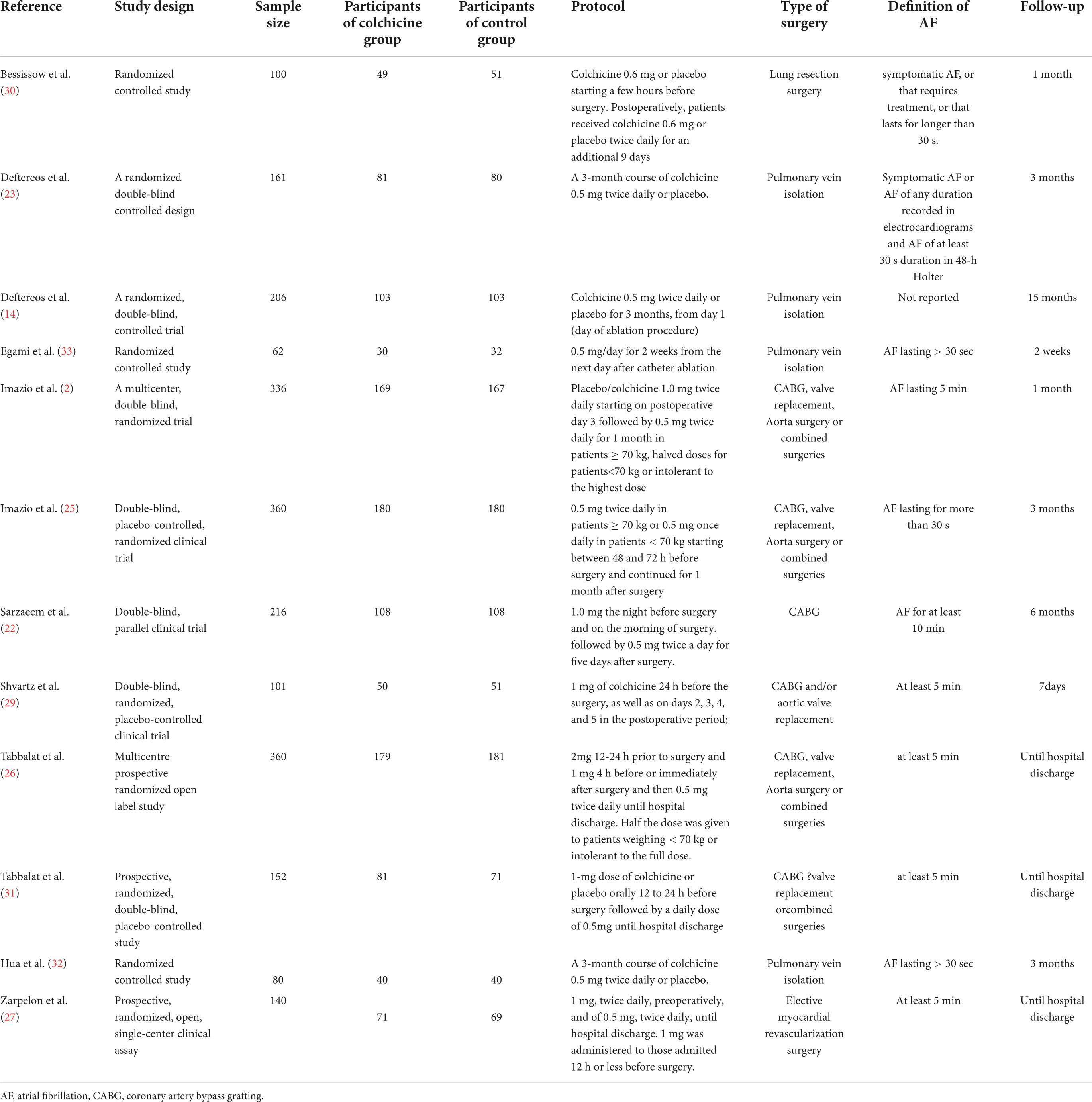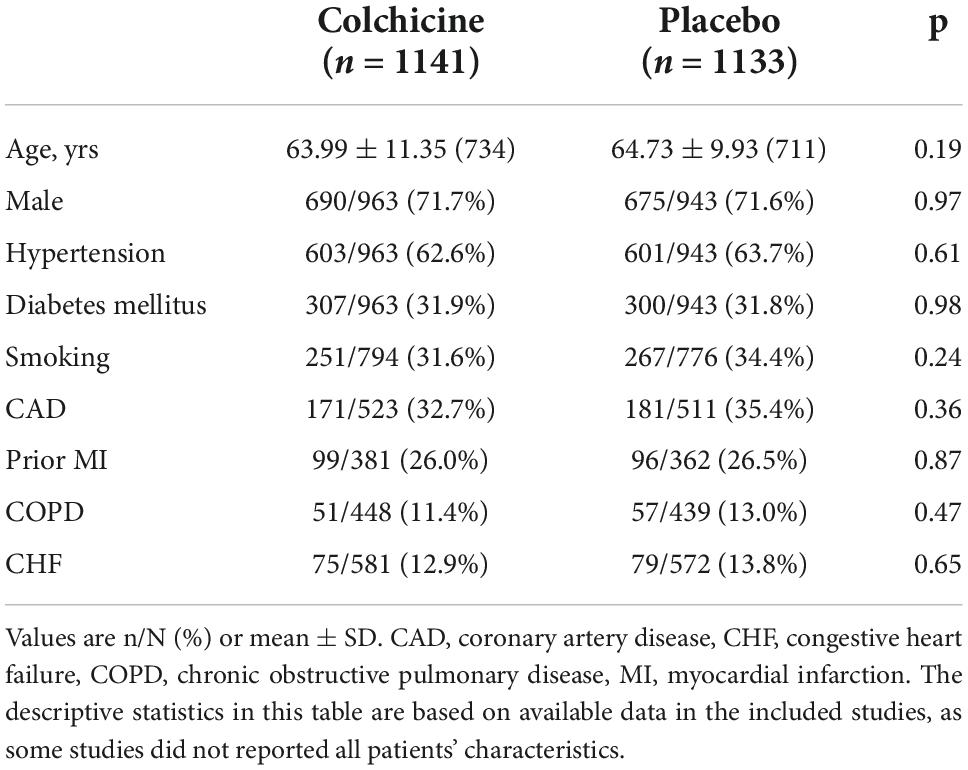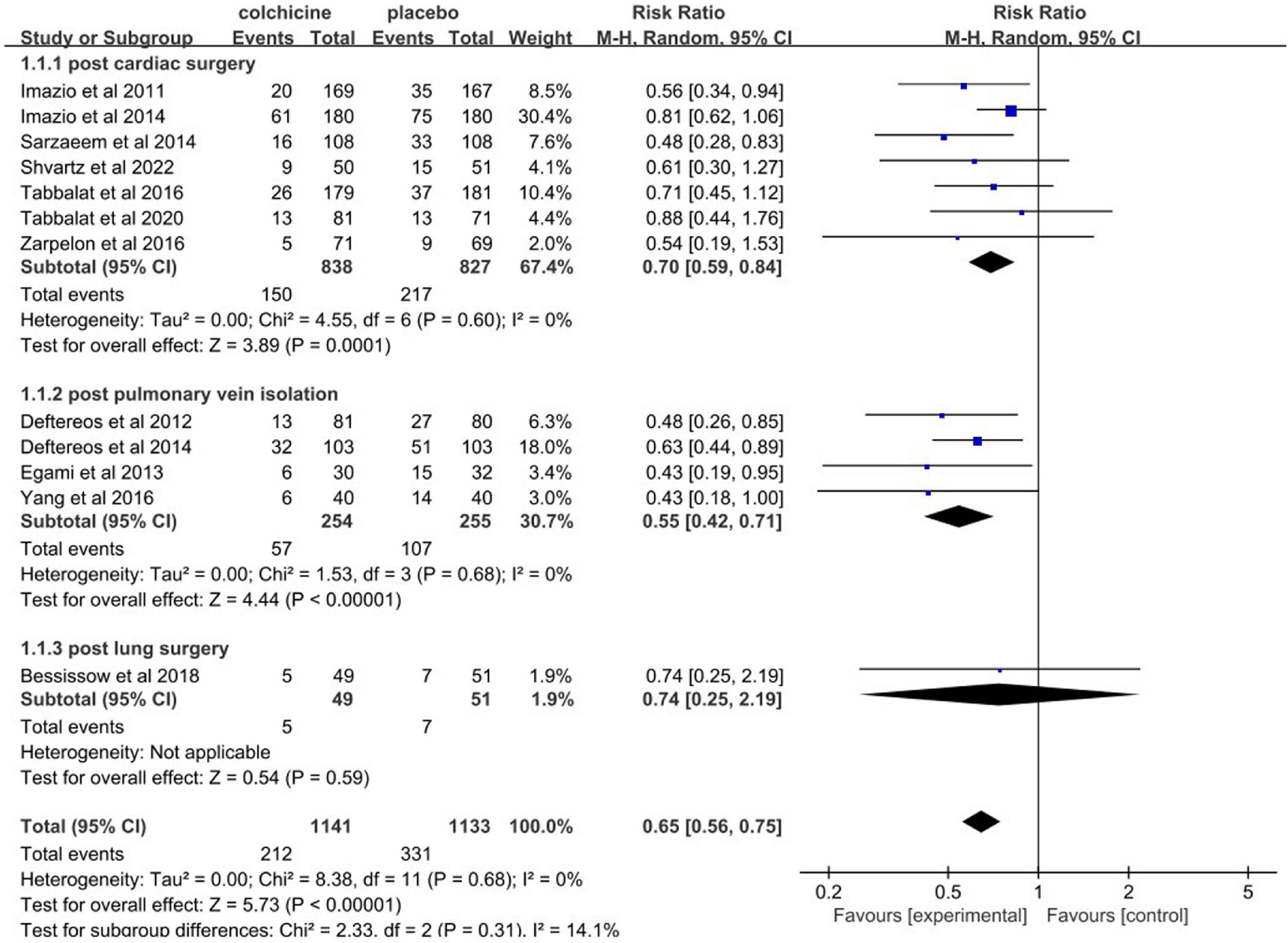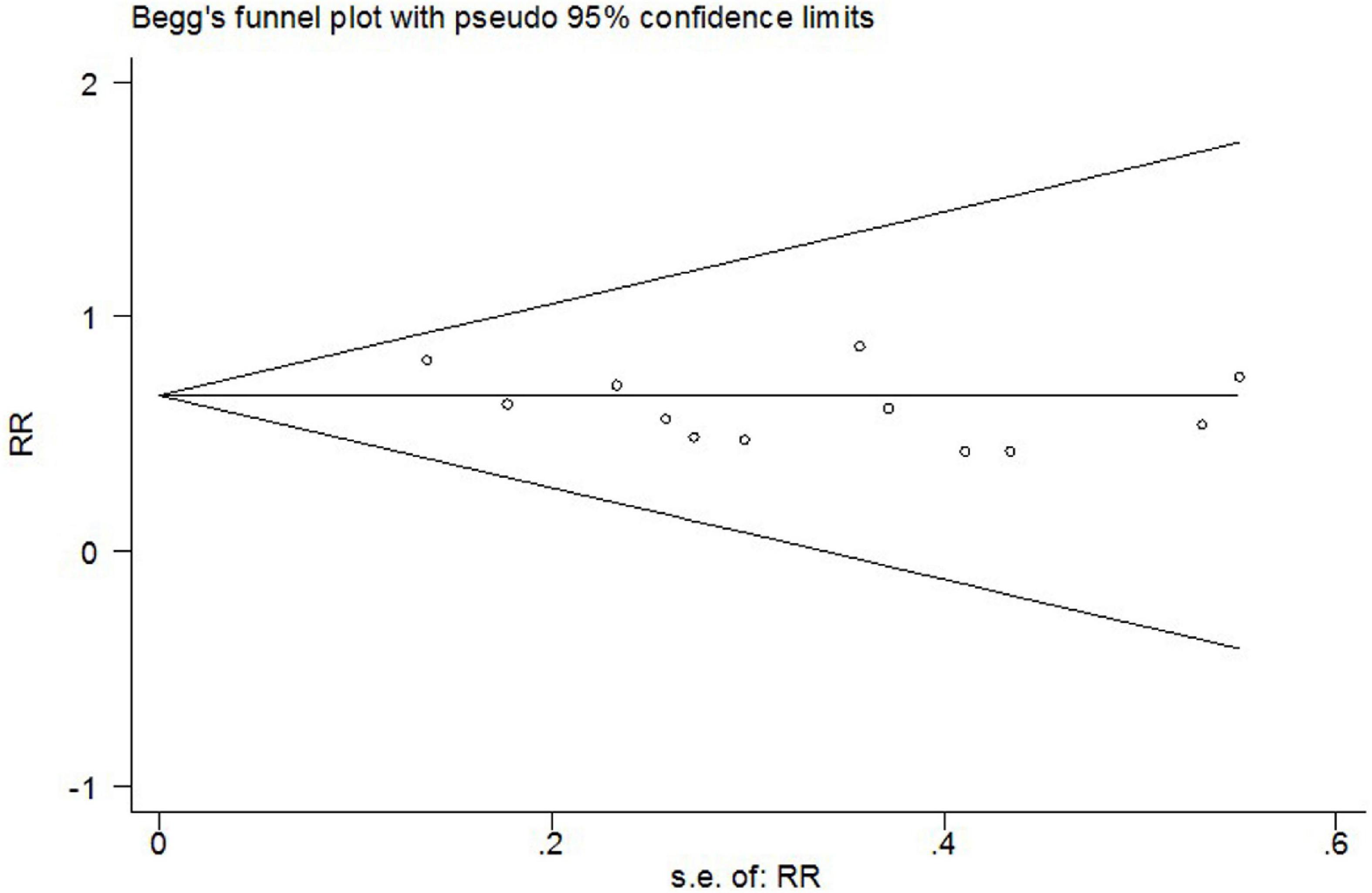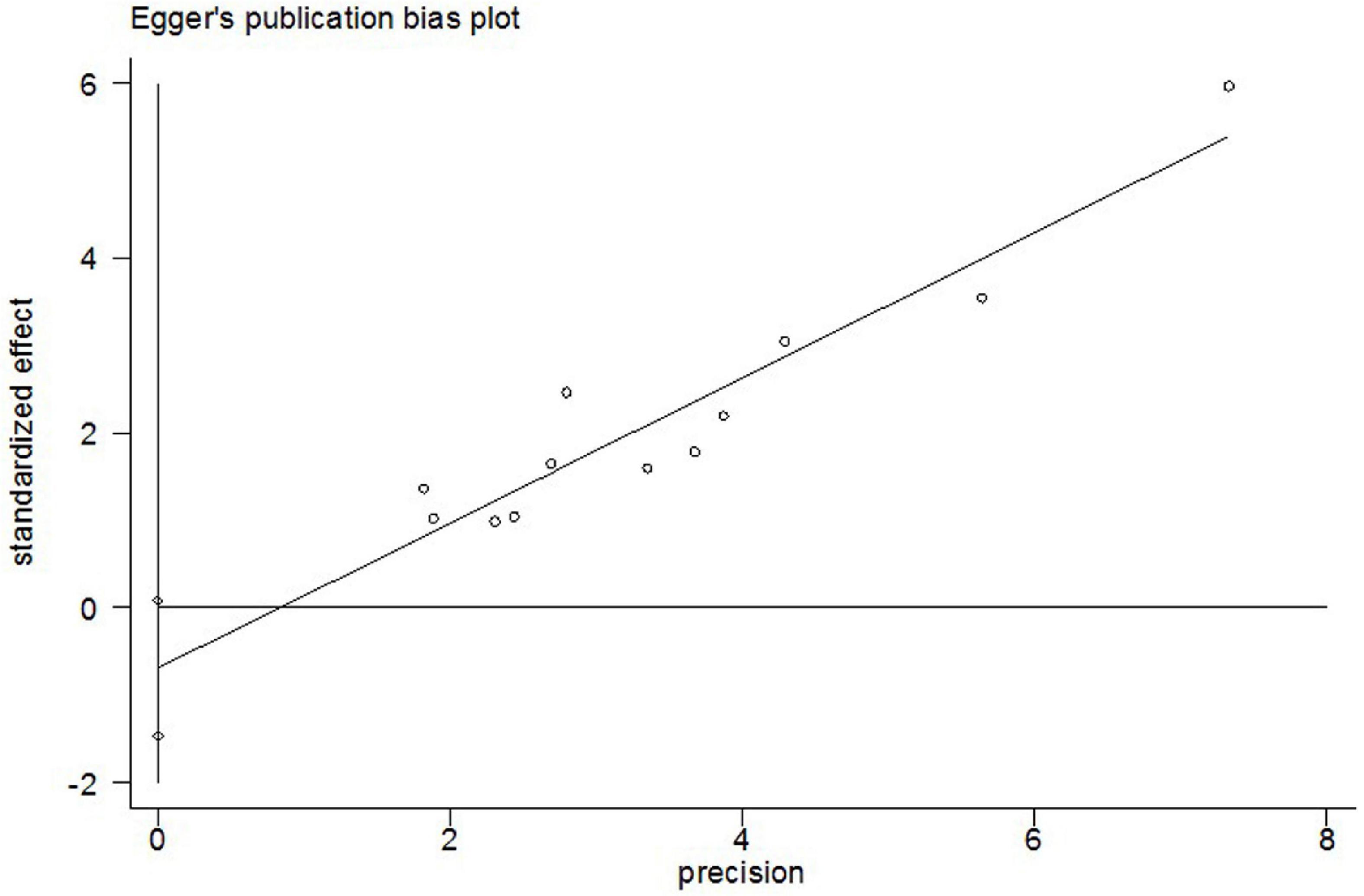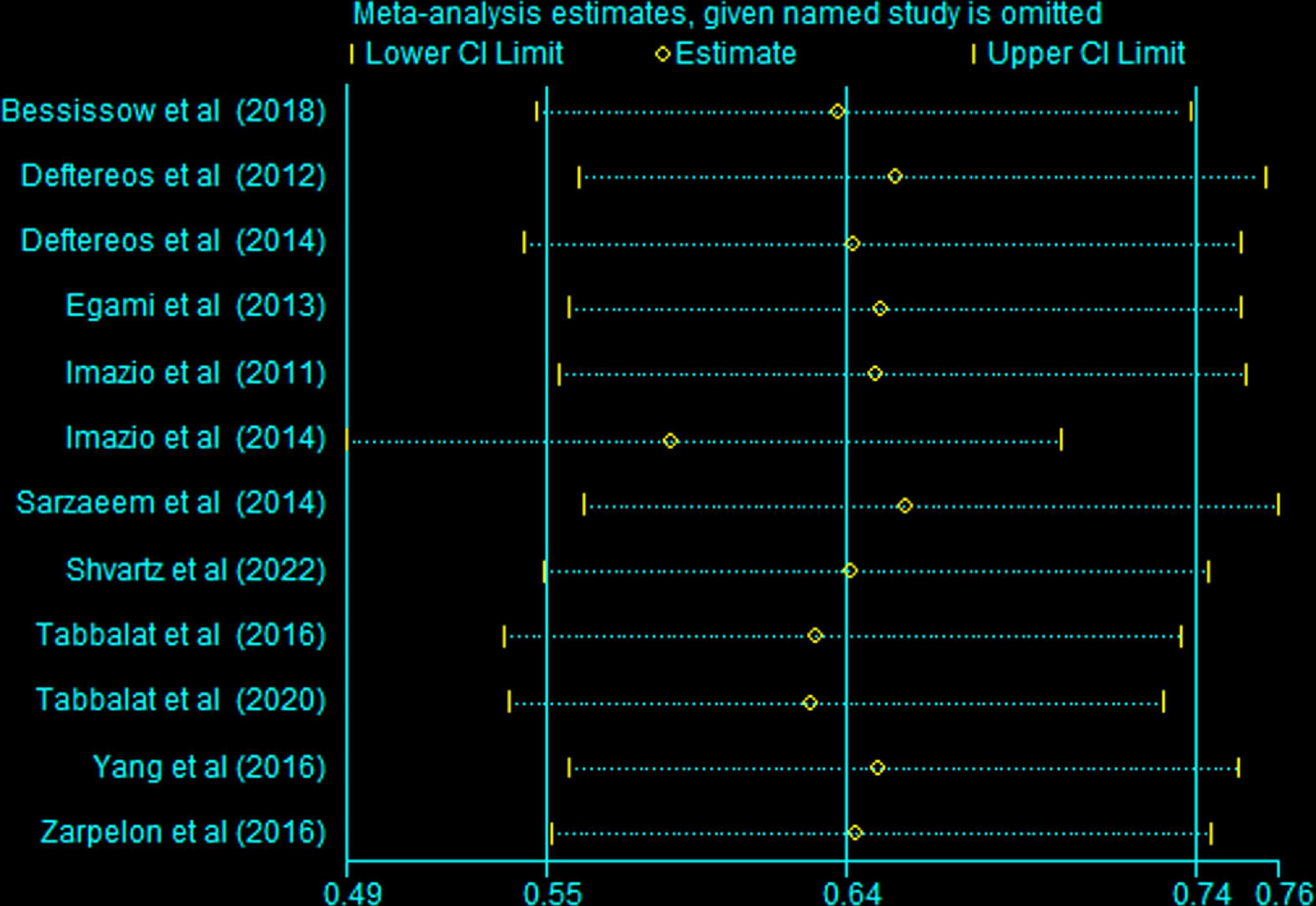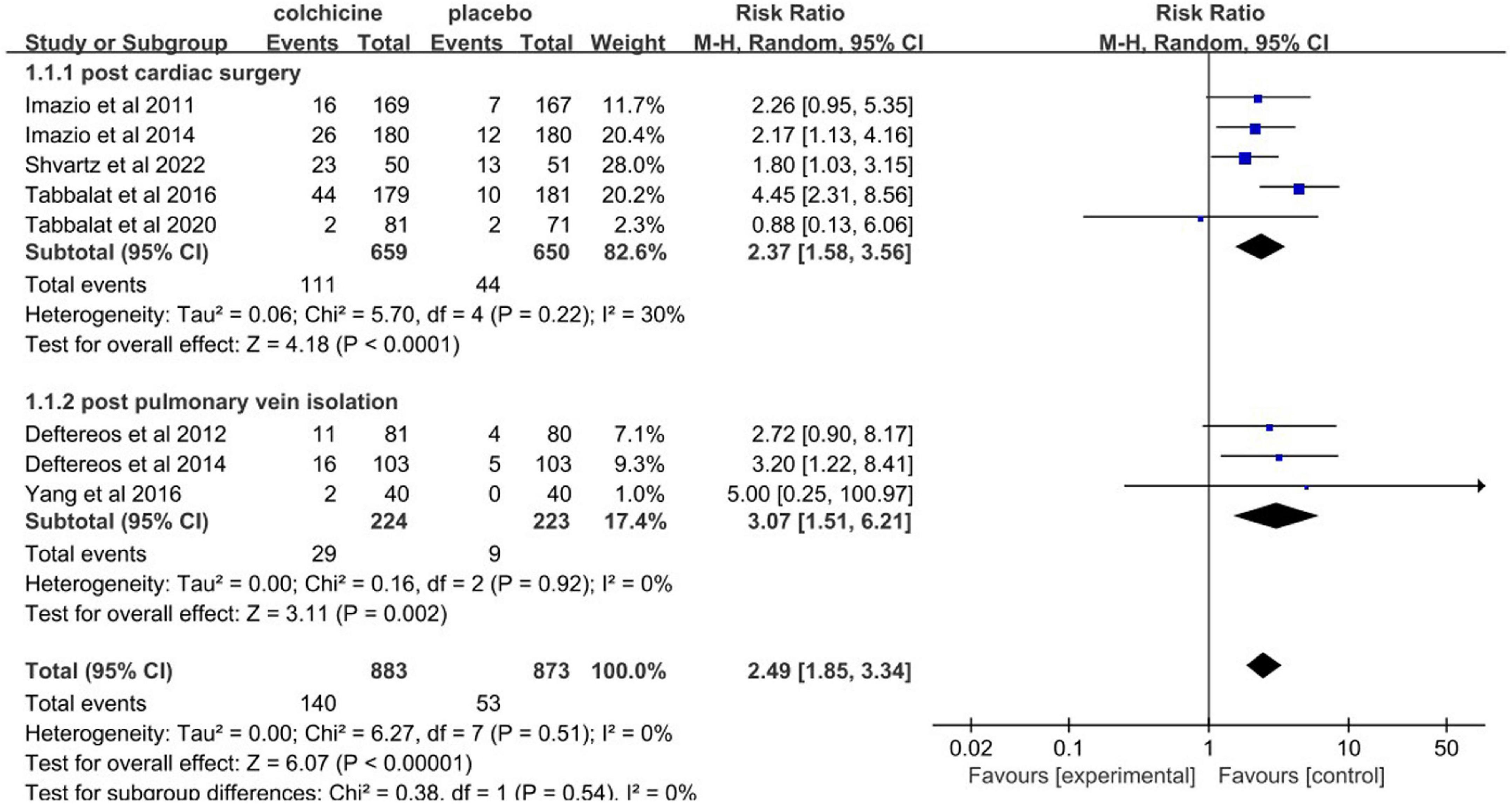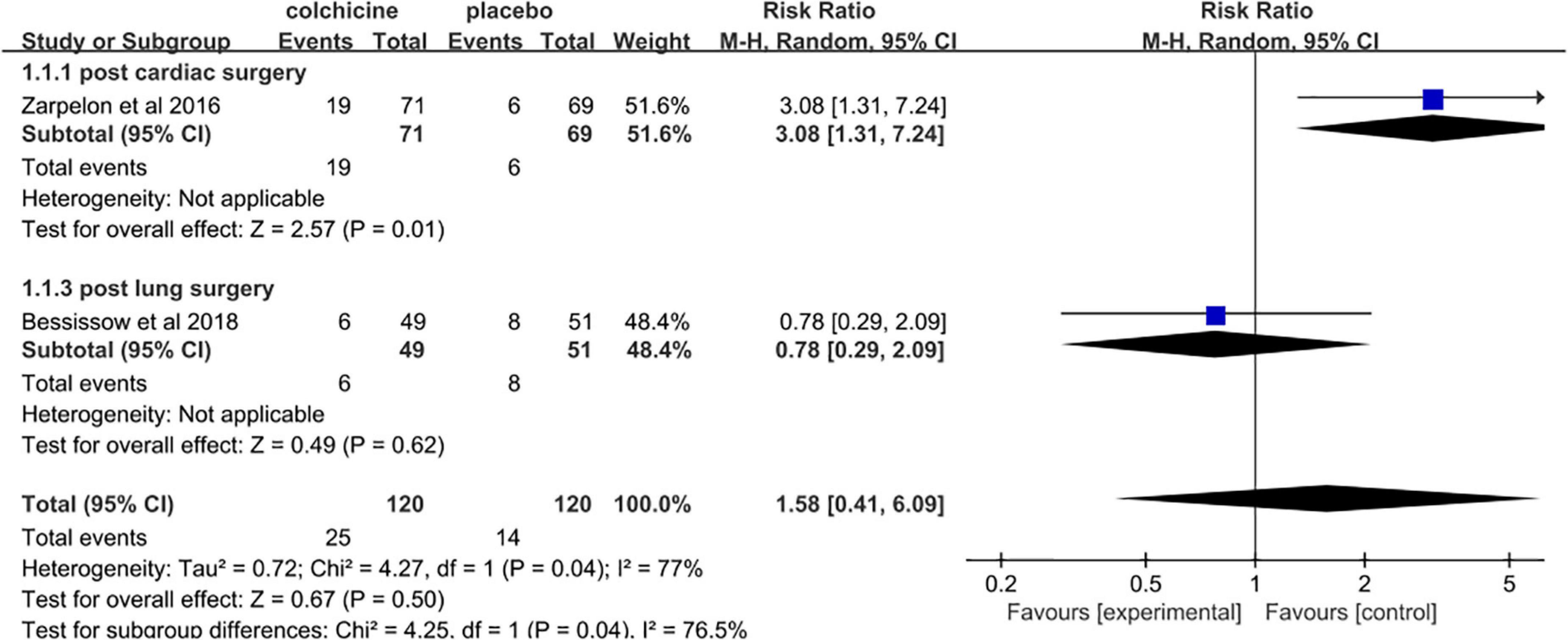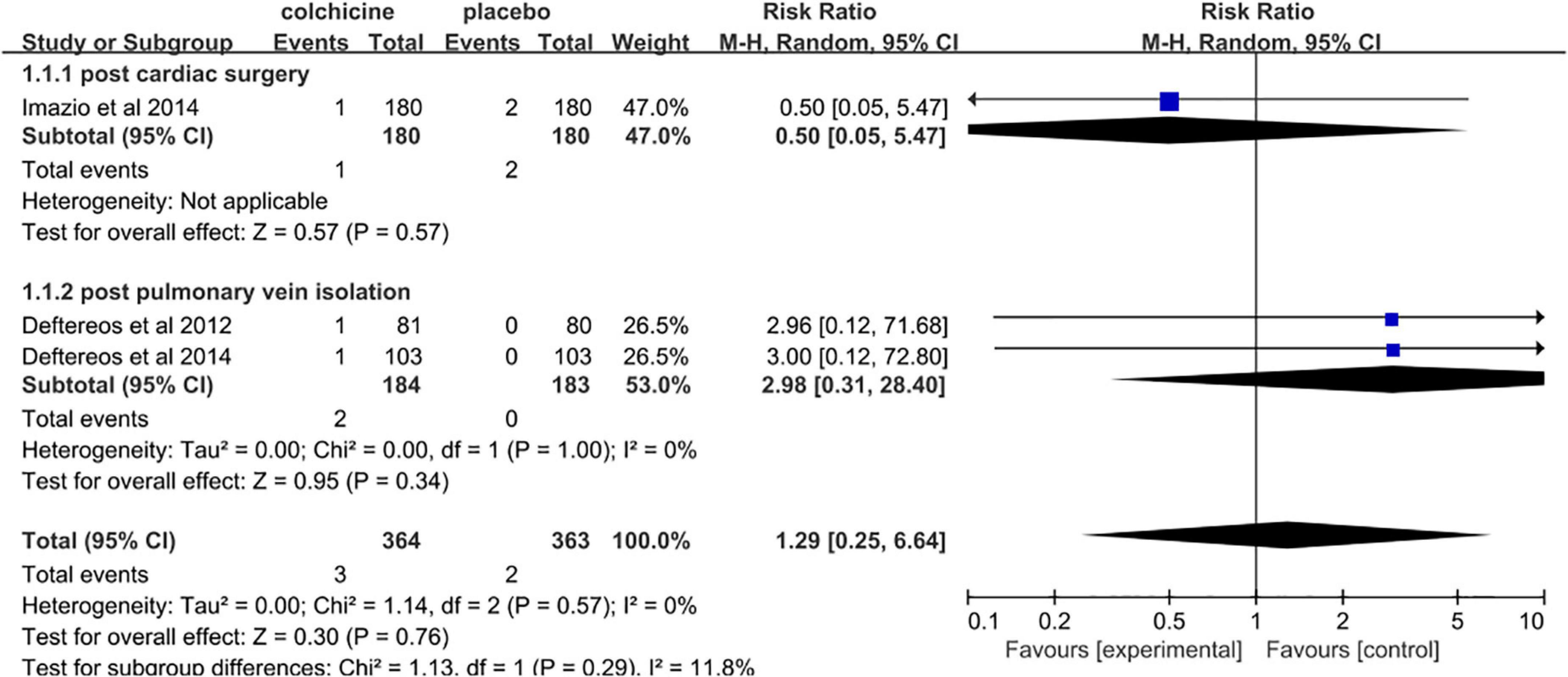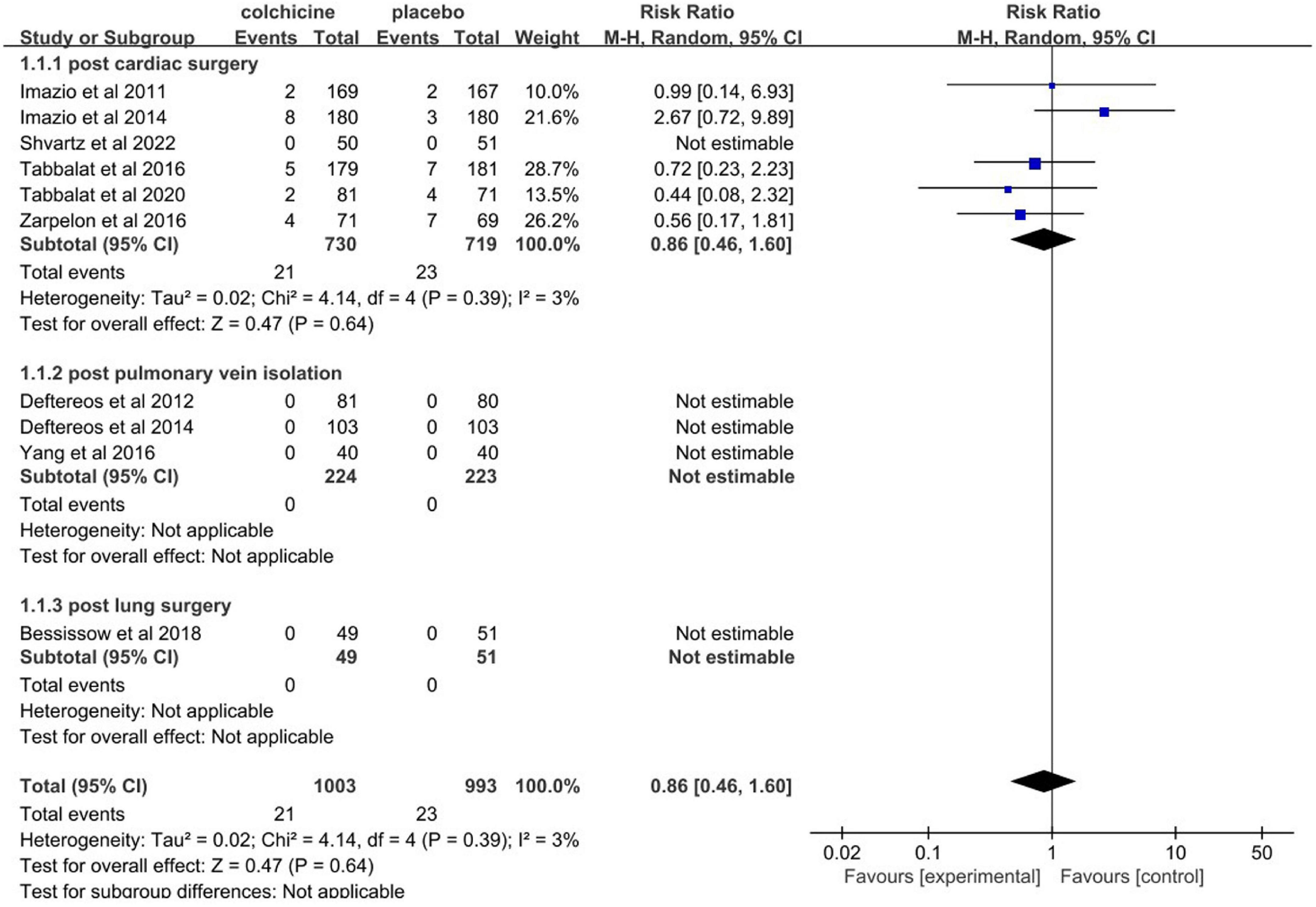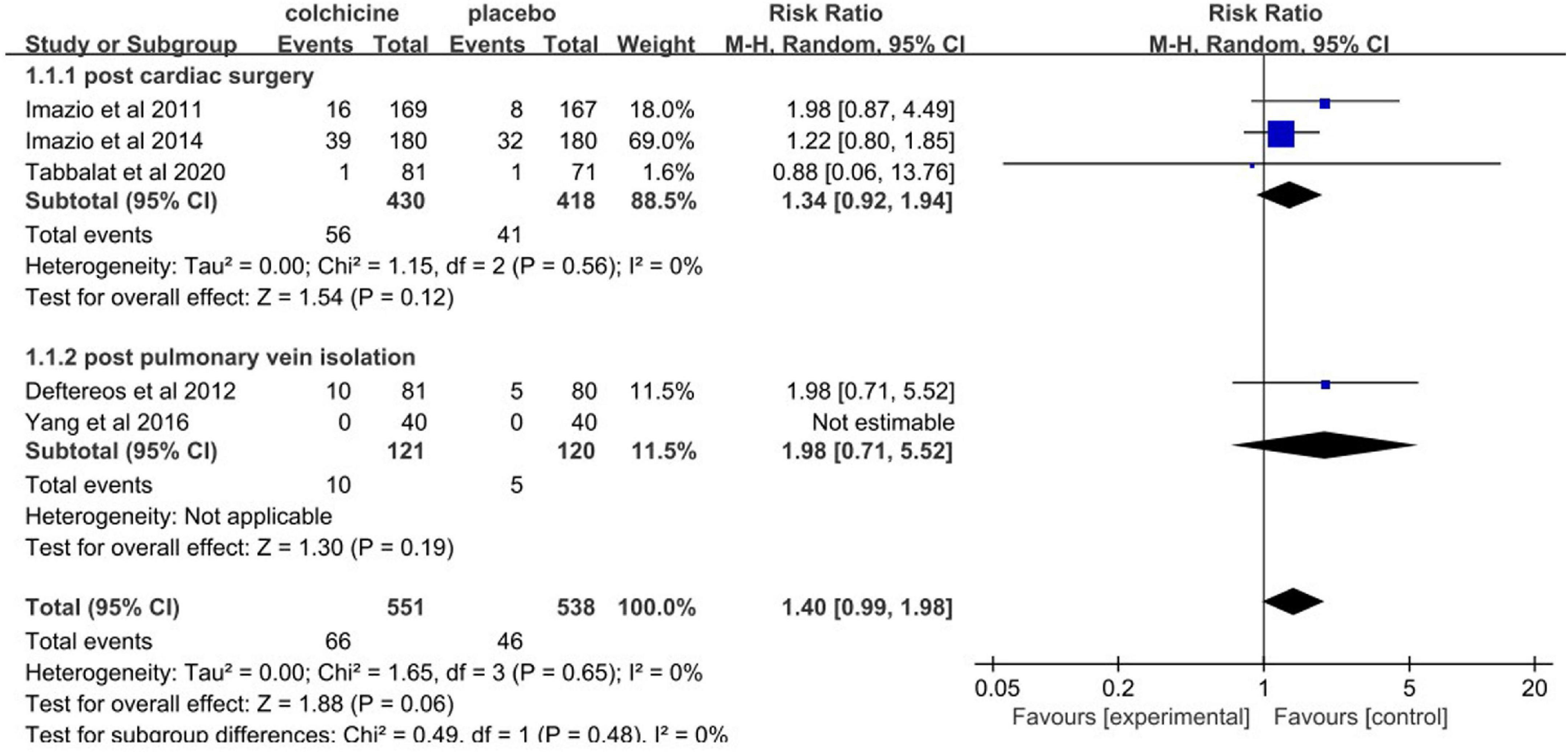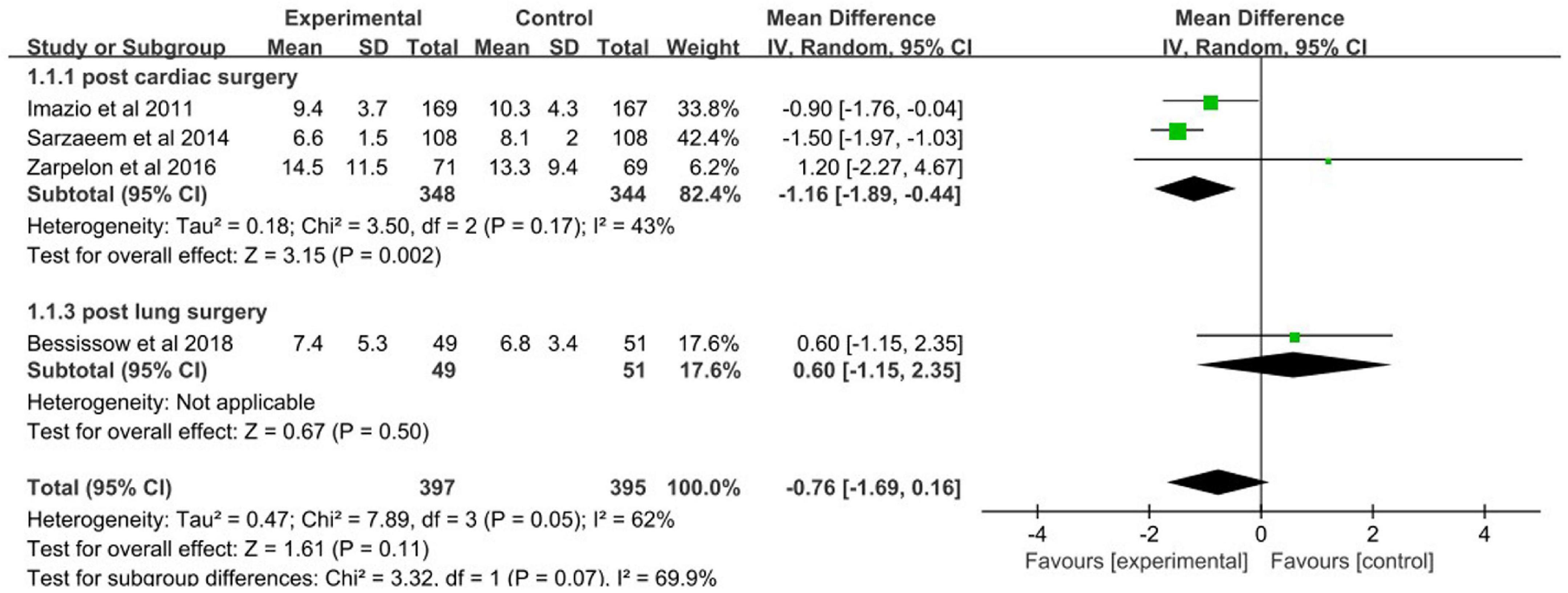- 1Shanghai General Hospital of Nanjing Medical University, Shanghai, China
- 2Department of Cardiology, The Affiliated Huaian No.1 People’s Hospital of Nanjing Medical University, Huaian, Jiangsu, China
- 3Department of Emergency and Critical Care, Shanghai General Hospital, Shanghai Jiao Tong University School of Medicine, Shanghai, China
- 4Department of Internal and Emergency Medicine, Shanghai General Hospital, Shanghai Jiao Tong University School of Medicine, Shanghai, China
- 5Department of Cardiology, Shanghai General Hospital, Shanghai Jiao Tong University School of Medicine, Shanghai, China
Objective: This study intended to assess the efficacy of colchicine for prevention of post-operative atrial fibrillation (AF).
Background: Post-operative AF is a common complication of surgery operations. Inflammation plays a crucial role in the pathogenesis of post-operative AF. Colchicine, a potent anti-inflammatory drug, may have a role in mitigating the incidence of post-operative AF.
Methods: We searched Cochrane Library, Web of Science, PubMed, China National Knowledge Infrastructure (CNKI), Database of Chinese sci-tech periodicals (COVIP), and Wanfang Database for randomized controlled trials (RCTs) comparing colchicine versus placebo, or usual care for prevention of post-operative AF. The main outcome was the occurrence of AF post operation, which includes cardiac surgery, lung surgery, or pulmonary vein isolation. The estimated risk ratio (RR) for the occurrence of post-operative AF was evaluated using a random-effects model. The safety end point was the development of any side effects.
Results: A total of 12 RCTs with 2274 patients were eventually included in this meta-analysis, where 1141 patients received colchicine and 1133 patients received placebo or usual care. Perioperative colchicine treatment was related to a decreased incidence of post-operative AF (RR: 0.65; 95% confidence interval [CI]: 0.56 to 0.75, p<0.001). Although the incidence of gastrointestinal side effects was increased with colchicine therapy when compared to placebo (RR = 2.49, 95% CI 1.85 to 3.34, p < 0.001), the incidence of major adverse events was not increased (RR = 0.86, 95% CI 0.46 to 1.60, p = 0.64).
Conclusion: In conclusion, the results of our meta-analysis suggest that colchicine treatment could lower the incidence of post-operative AF. Further studies are needed to determine the optimal colchicine treatment regime to minimize the incidence of adverse events.
Introduction
Atrial fibrillation (AF) is a prevailing arrhythmia worldwide. It is suggested that AF prevalence is about 3% in adults (1). Post-operative AF is a common complication of surgery operations, especially cardiac surgery. The prevalence of AF after cardiac surgery varies between 10 and 65%, depending on the different surgery type, patient character, and the definition of post-operative AF (2–4). Postoperative AF also occurs in 10- 30% of patients after non-cardiac thoracic surgery (5). Post-operative AF is associated with longer hospital stays, increased incidence of stroke, increased patient mortality, and increased healthcare costs (2, 6, 7). Therefore, prevention of post-operative AF is emphasized by multiple guidelines (1, 8, 9). Many factors may contribute to the development of post-operative AF, such as inflammation, sympathetic/parasympathetic activation, oxidative stress, and structural substrates for electrical re-entry pathways created by surgical procedure (10–12). Prior studies have demonstrated that inflammatory markers like C-reactive protein [CRP] were increased in the group who developed post-operative AF (13–15). Consequently, anti-inflammatory therapy could be useful in preventing the development of post-operative AF. Some anti-inflammation drugs, including corticosteroid therapy, non-steroidal anti-inflammatory drugs (NSAIDs), statin, and colchicine, have been assessed to prevent post-operative AF (2, 16–18).
Colchicine is a potent anti-inflammatory drug which is used in clinic for centuries (19). Unlike NSAIDs and glucocorticosteroids, colchicine has a different mechanism of action that does not relate to the arachidonic acid pathway. Its anti-inflammatory action is mainly related to the inhibition of tubulin polymerization/assembly. Thereby, colchicine inhibits cell mitosis and neutrophil motility (20, 21).
Yet recent studies did not reach an agreement on the efficacy of colchicine in preventing post-operative AF. Some clinical studies and meta analyses favor the use of colchicine to prevent postoperative atrial fibrillation (2, 14, 22–24), while others do not (25–28). In recent years, several new clinical trials on colchicine have been conducted and reported (29–31). In our study, we focus on the available RCTs to evaluate the efficacy and safety of colchicine in prevention of post-operative AF (2, 14, 22, 23, 25–27, 29–33).
Materials and methods
Search strategy
This meta-analysis was performed in accordance with the Preferred Reporting Items for Systematic Reviews and Meta-analysis (PRISMA) statement (34). A systematic search was conducted for eligible studies. The following databases were searched: Cochrane Library, Web of Science, PubMed, China National Knowledge Infrastructure (CNKI), Database of Chinese sci-tech periodicals (COVIP), and Wanfang Database. Literature searches were completed on May 1, 2022. The following key words were used: atrial fibrillation, or AF, and colchicine. In order to mitigate publication bias, reference lists within the selected articles and relevant review articles were also scanned for additional studies that may meet inclusion criteria. No language or publication year restriction was applied for the initial extraction of the data. All references of the related trials were reviewed.
Study selection
Our selection criteria were: (1) only randomized controlled trials (RCTs); (2) study patients who underwent any cardiac surgery, or pulmonary vein isolation (PVI), or any lung surgery; (3) comparisons of colchicine versus placebo, or usual care. Any colchicine treatment regime and dose were accepted. The exclusion criteria were as follows: (1) studies with inadequate outcome data to meet our primary endpoint. Our primary endpoint was the occurrence of post-operative AF, defined as documented AF lasting for more than 30 s following any cardiac surgery, or lung surgery, or PVI. Secondary outcomes of interest were the incidence of adverse events, including adverse effects related to colchicine therapy and major adverse events. Adverse effects related to colchicine therapy referred to gastrointestinal side effects (nausea, diarrhea or vomiting), infection, and hepatotoxicity. Major adverse events were defined as stroke and all-cause death.
Two investigators (Ge Peibing and Fu Yu) independently performed the study selection. During the study selection process, any disagreements were settled by discussion among co-authors. Titles and abstracts of related references were screened for inclusion. Then irrelevant publications were excluded. Full texts of potential articles were downloaded and further evaluated to find whether they meet inclusion criteria (Figure 1). Case reports, editorials, letters, and meta-analyses or systematic reviews were excluded. At last, there were twelve RCTs that evaluated the effectiveness and safety of colchicine in preventing AF after cardiac surgery, or PVI, or lung surgery.
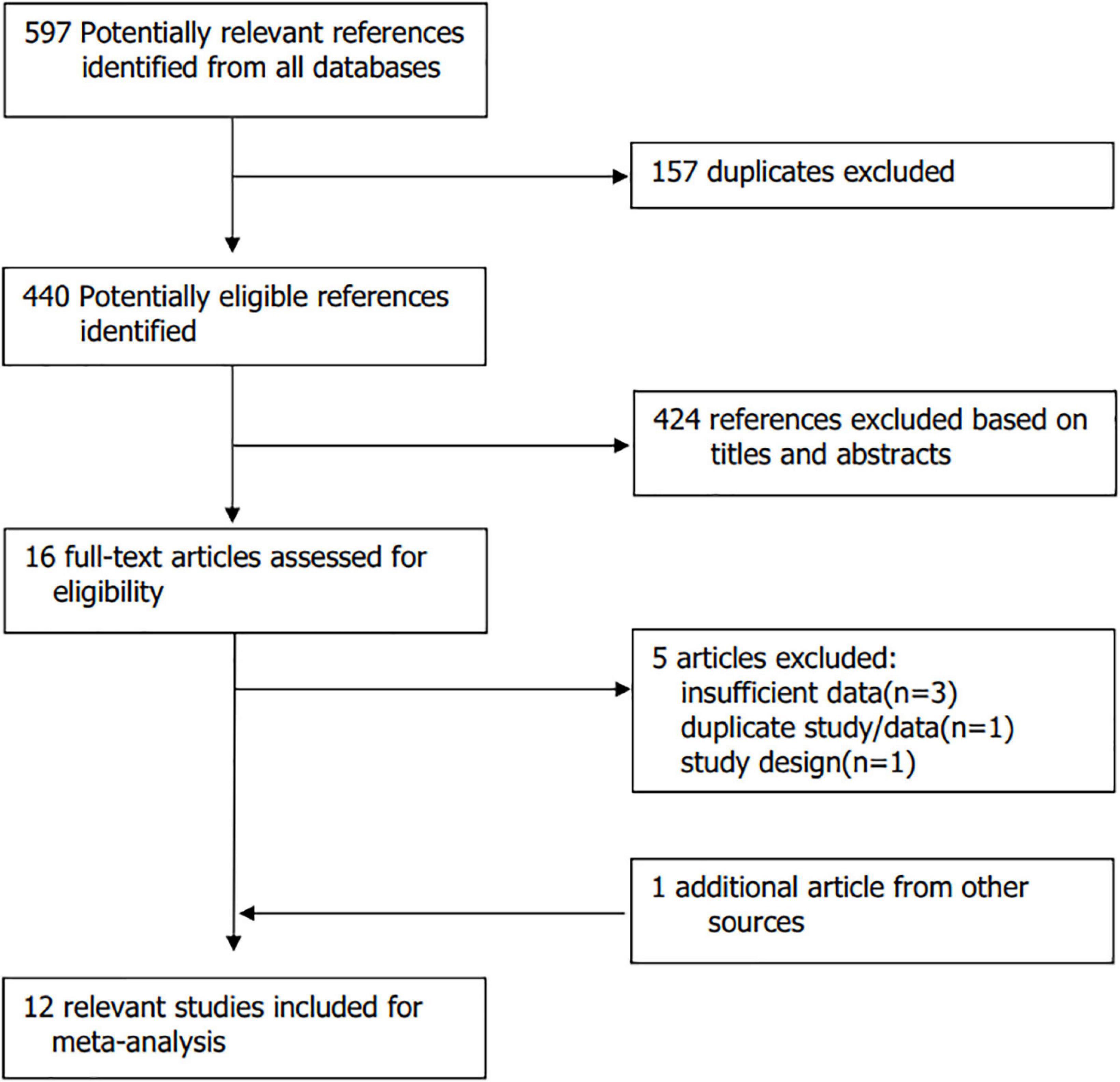
Figure 1. Flow chart. A total of 12 studies were included finally. Reason for exclusion of possibly eligible studies are listed.
Quality assessment
The Cochrane Risk of Bias tool by Review Manager were applied to appraise the quality of the included articles. The risks of bias were divided as high risk, or unclear risk, or low risk. Disagreements were resolved by discussion among co-authors.
Data extraction
We extracted information on publication year, first author’s name, study design, sample size of intervention group and control group, population characteristics, surgery type, dose and time period of colchicine, and outcomes and results. Two independent authors (Ge Peibing and Fu Yu) conducted data extraction. Any disagreements were settled by discussion between the two authors.
Statistical analysis
Review Manager (RevMan) 5.4 software (available from The Cochrane Collaboration) and STATA 12.0 (StataCorp, College Station, Texas) were applied to statistical analysis. This meta-analysis was performed using the Mantel-Haenszel method and a random effects model. To assess heterogeneity, we applied chi-square test, Tau-square test. To evaluate the proportion of the overall variability in the estimates caused by between-study variation, I-square (I2) statistics was performed. I2 of <25%, 25% to 50%, and >50% were defined as low, moderate, and high amounts of heterogeneity, respectively. Potential publication bias was evaluated by using the Begg’s test and Egger’s test. To assess additional factors impacting these results, we performed subgroup analysis based on type of surgery. Sensitivity analysis was used by repeating the calculations 12 times and by removing one study at a time.
Continuous data were expressed as mean ± standard deviation (SD). Categorical variables were presented as numbers or percentages. Student’s t-test was used for comparison of continuous data of pooled groups of colchicine and placebo participants. Pearson chi-square tests were applied to compare pooled groups of colchicine and placebo participants on categorical variables. These analyses were conducted with the SPSS 22.0 software package (SPSS, Inc., Chicago, IL). All comparisons were 2-sided, and a p < 0.05 was considered statistically significant in this meta-analysis.
Results
Search results
The study selection process is illustrated in Figure 1. Our initial search yielded 597 references. Of those, a total of 157 references were excluded because of duplicated publication. Of the remaining 440 potentially eligible references, 424 references were removed after screening titles and abstracts because of irrelevance to our topic. The rest 16 references relevant to our topic were selected and the full text of those articles were download for further evaluation. Five publications were excluded because of no available data, duplicate study/data, study design. One additional record identified from relevant review articles was added. Therefore, a total of 12 studies with 1141 patients randomized to receive colchicine and 1133 patients to receive placebo were eventually included in this meta-analysis (2, 14, 22, 23, 25–27, 29–33).
Baseline characteristics
Table 1 summarizes study baseline characteristics of the 12 included RCTs. Seven RCTs enrolled patients who underwent cardiac surgery [Cardiac surgery included coronary artery bypass grafting (CABG), surgery for aortic diseases, and valve surgery], and 4 RCTs enrolled patients who underwent PVI, and 1 RCT enrolled patients who underwent lung surgery. Colchicine treatment regime varied with respect to dose, initiation time, and treatment duration. Among the included RCTs, 5 trials had 1-month to 3-month treatment duration, and 7 trials had less than 1 month treatment duration. Follow-up ranged from hospital stay time to 15 months. AF was detected either by 12-lead ECG-recording or continuous ECG monitoring.
Table 2 summarizes baseline clinical characteristics of included RCTs. The mean age was 64-years and on average, males accounted for about 72% of subjects. Comparison between colchicine and placebo groups showed no difference in prevalence of hypertension (62.6% vs. 63.7%; p = 0.61), diabetes mellitus (31.9% vs. 31.8%; p = 0.98), congestive heart failure(12.9% vs. 13.8%; p = 0.65), coronary artery disease(32.7% vs. 35.4%; p = 0.36), prior myocardial infarction(26.0% vs. 26.5%; p = 0.87), chronic obstructive pulmonary disease(11.4% vs. 13.0%; p = 0.47), smoking status(31.6% vs. 34.4%; p = 0.24).
Quality assessment
Figure 2 shows the risk of bias assessment of the included studies. We used random sequence generation, allocation concealment, blinding of participants and personnel, blinding of outcome assessment, incomplete outcome data, and selective reporting as the main determinants of the quality of a study. Two trials present high risk of bias in “blinding of participants” and in “blinding outcome assessment” (26, 27). No appreciable difference was found in the efficacy of colchicine for prevention of post-operative AF after the two trials were excluded (Figure 3).
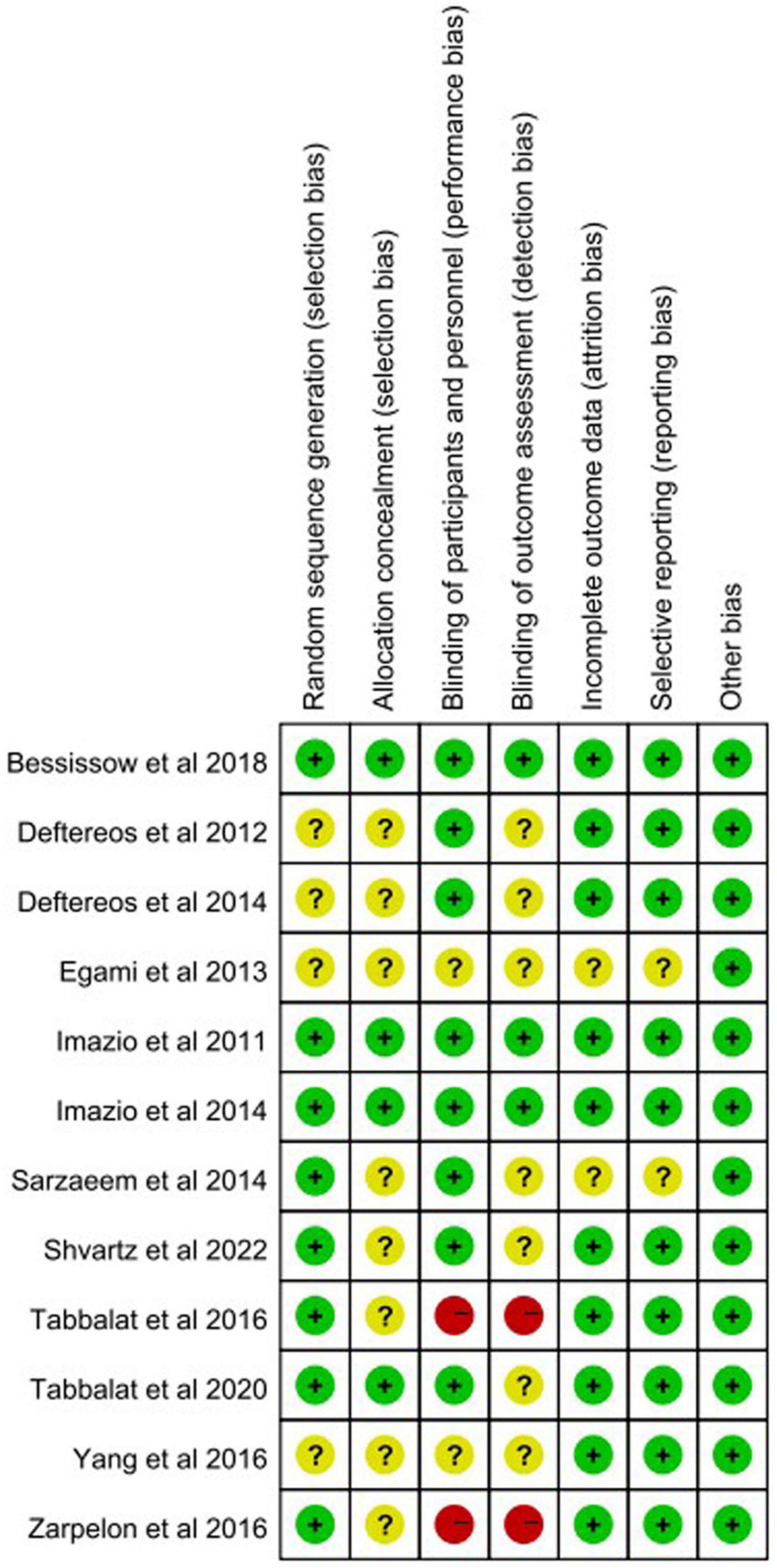
Figure 2. Quality assessments for included studies. Green/plus indicates low risk of bias, yellow/question mark suggests the uncertain risk of bias, and red/minus shows potential high risk of bias.
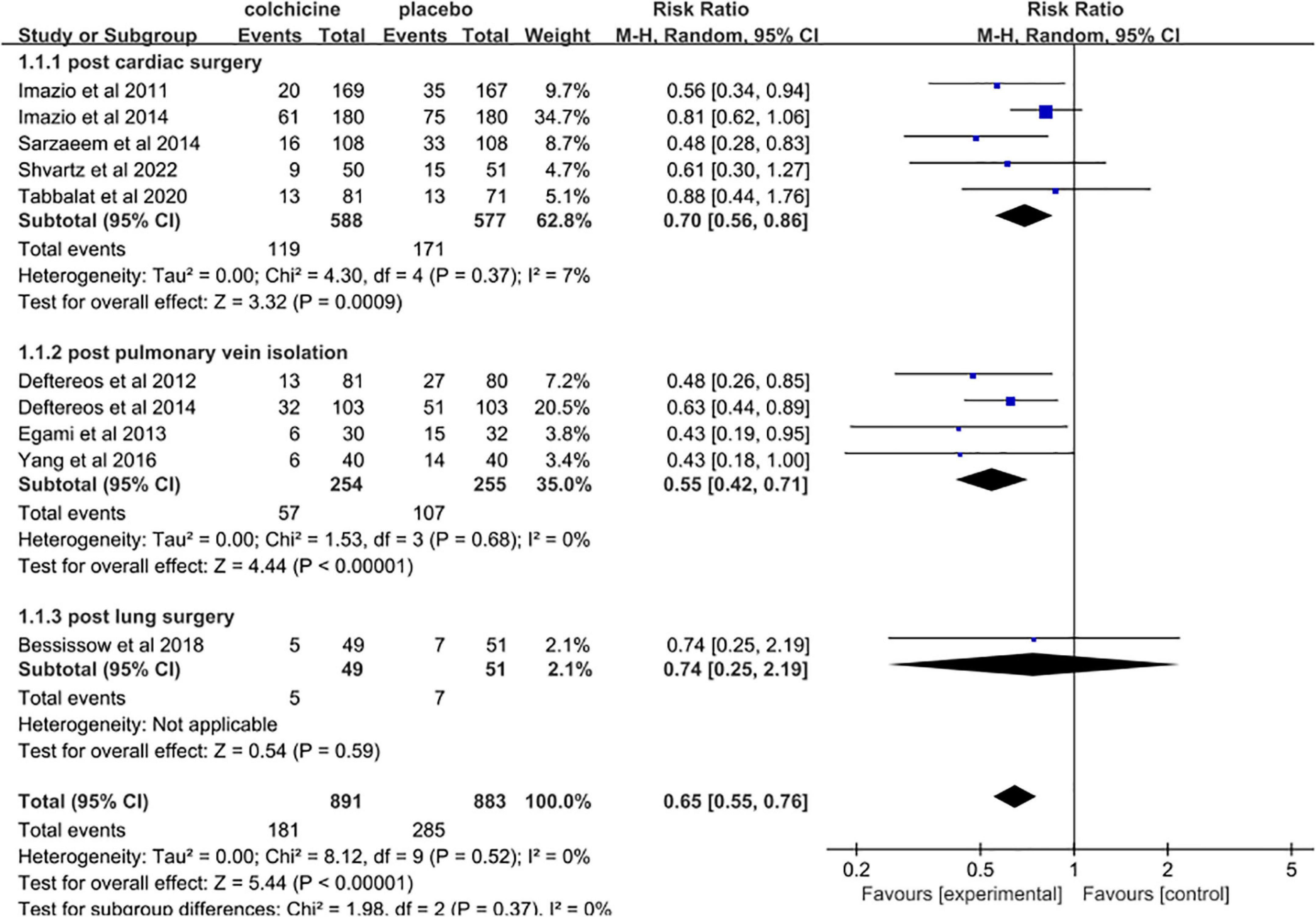
Figure 3. Forest plot indicates risk ratios of post-operative atrial fibrillation with colchicine after the two trials were excluded.
Prevention of post-operative atrial fibrillation
The incidence of post-operative AF in control groups ranges from 13 to 50%. Colchicine therapy to prevent post-operative AF was associated with a reduction of 35% (RR 0.65, 95% CI 0.56 to 0.75, p < 0.001, I2 = 0%) when compared to placebo (Figure 4). In the colchicine group, 18.6%(212/1141) suffered from post-operative AF versus 29.2% (331/1133) of control patients. Because of the treatment regime and follow up heterogeneity of the included studies, we used the random-effects model in this meta-analysis. There was low heterogeneity among the included studies using the random method (I2 = 0%, χ2 = 8.38, df = 11, p = 0.68). Seven studies showed no differences between colchicine therapy and placebo or usual care. The Begg’s test and Egger’s test were applied to assess publication bias (Figures 5, 6). They show a nearly symmetrical distribution of the plot, which could suggest no significant publication bias.
As displayed in Figure 4, subgroup analysis demonstrates reductions in the occurrence of post-operative AF in post cardiac surgery (RR 0.70, 95% CI 0.59 to 0.84, p < 0.001, I2 = 0%) and in post pulmonary vein isolation (RR 0.55, 95% CI 0.42 to 0.71, p<0.001, I2 = 0%) when comparing to placebo. Whereas in post lung surgery, colchicine therapy did not statistically significantly reduce the incidence of post-operative AF (RR 0.74, 95% CI 0.25 to 2.19, p = 0.59).
Sensitivity analysis
In this meta-analysis, we conducted sensitivity analysis by removing each study in turn. As showed in Figure 7, the overall risk ratio ranged from 0.59 (95%CI 0.49 to 0.70) (Imazio et al.) to 0.65 (95%CI 0.56 to 0.76) (Sarzaeem et al.). The 95% CIs and the point estimates did not change greatly. Therefore, our results are not dependent upon a single study.
Adverse effects related to colchicine therapy
Pooled data analysis revealed that colchicine therapy was related to a 2.49 fold increased risk for gastrointestinal adverse effects compared to usual care or placebo (RR = 2.49, 95% CI 1.85 to 3.34, p < 0.001, I2 = 0%). 15.9% (140/883) who received colchicine therapy experienced gastrointestinal adverse effects versus 6.1% (53/873) of control patients (Figure 8). Only two trials reported the incidence of infection. The overall incidence of infection was about 20.8% (25/120) for colchicine and 11.7% (14/120) for controls (RR = 1.58, 95% CI 0.41 to 6.09, p = 0.50, I2 = 77%) (Figure 9). Three trials reported the incidence of hepatotoxicity. The overall incidence of hepatotoxicity was about 0.8% (3/364) for colchicine and 0.6% (2/363) for controls (RR = 1.29, 95% CI 0.25 to 6.64, p = 0.76, I2 = 0%) (Figure 10).
Major adverse events
Ten trials [Bessissow et al. (30); Deftereos et al. (23); Deftereos et al. (14); Imazio et al. (2); Imazio et al. (25); Shvartz et al. (29); Tabbalat et al. (26); Tabbalat et al. (31); Hua et al. (32) and Zarpelon et al. (27)] reported major adverse events (stroke and all-cause death). Pooled data revealed that the overall incidence of major adverse events was about 2.1% (21/1003) for colchicine and 2.3% (23/993) for controls (RR = 0.86, 95% CI 0.46 to 1.60, p = 0.64, I2 = 3%) (Figure 11).
Accordingly, there was no evidence to reject the null hypothesis of no difference between colchicine therapy and placebo or usual care in major adverse events.
Early treatment discontinuation
Early treatment discontinuation was reported in five studies. Pooled data revealed that there was no significant difference in the rate of early treatment discontinuation between colchicine group and placebo group (RR: 1.40; 95% CI: 0.99 to 1.98; p = 0.06) (Figure 12).
Hospital length-of-stay
Colchicine treatment was not statistically significantly related to a reduction in hospital length-of-stay (mean difference: –0.76 days, 95% CI: –1.69 to 0.16; p = 0.07) (Figure 13). But there was a trend that patients in colchicine treatment group had a shorter hospital length-of-stay (p = 0.07).
Discussion
To the best of our knowledge, this meta-analysis is the largest one on the efficacy of colchicine to prevent post-operative AF. This meta-analysis included 12 RCTs which enrolled a total of 2274 patients undergoing cardiac surgery, lung surgery and PVI for AF. It demonstrates that the administration of colchicine in the perioperative period results in significantly lower rate of post-operative AF. However, colchicine was also associated with a higher rate of occurrence of side effects, especially gastrointestinal adverse effects, compared to placebo. Previous meta-analyses have shown inconsistent results regarding the efficacy of colchicine for prevention of post-operative AF. Only three trials were included in the studies of Lee et al. and Wang et al. respectively (24, 28). Our studies provide more information regarding the adverse effects related to colchicine therapy, and major adverse events (35).
The exact pathophysiology of post-operative AF is remained to elucidate. It is regarded as multifactorial, including autonomic nervous system imbalance, pericardial inflammation, hypoxia, and metabolic and electrolyte disturbances (10–12, 36). Mounting evidence suggests that inflammation is a major factor in the development of post-operative AF (12, 36). Inflammatory biomarkers such as C-reactive protein and interleukin-6 are associated with the incidence of post-operative AF (13–15, 37, 38). The NLRP3 inflammasome activation plays a vital role in the secretion of the inflammatory cytokines which are involved in the occurrence of AF (39). The administration of corticosteroids is related to the reduction of AF recurrences after cardiac surgery or PVI (12, 40). Microtubules play a key role in cellular cytoskeletal and intracellular transport activities. Colchicine can disrupt microtubule assembly in cells (41, 42). Moreover, colchicine inhibits the assembly of the NLRP3 inflammasome, prevents the activation of caspase-1, and reduces the release of IL-1β, IL-6 and superoxide (43–45). Both the whole-cell and single channel currents activated by cell mechanical deformations were completely blocked by colchicine administration in rat atrial fibroblasts (46). Together, colchicine has the ability to inhibit leukocytes functions and exert its anti-inflammatory function (19, 21). Colchicine also has anti-fibrosis effects and a variety of effects on endothelial function (47).Post-operative AF is related to an increased hospital stay, poorer neurocognitive outcomes, elevated health care costs, and increased incidence of stroke and death (2, 6, 7). Our meta-analysis reveals that there was a trend that patients in colchicine treatment group had a shorter hospital length-of-stay when comparing to patients in placebo treatment group. Although colchicine therapy increased the occurrence of gastrointestinal adverse effects, the rate of early treatment discontinuation did not rise in colchicine treatment group. Furthermore, pooled data suggested colchicine treatment did not increase the major adverse events. There was no significant difference in the incidence of hepatotoxicity and infection between the two groups. However, only a few trials reported the incidence of hepatotoxicity and infection, and more trials are needed. Given the undesirable clinical outcomes, related health care costs, and safety of colchicine, colchicine may be recommended as a prophylactic drug in patients to reduce the incidence of post-operative AF.
Previous studies show that many drugs such as amiodarone, beta-blockers, colchicine, corticosteroids, magnesium, and statins, have been assessed for potential roles to lower the incidence of post-operative AF (2, 16–18, 48–50). However, only amiodarone and beta-blockers get a class I recommendation by international guideline (1). Amiodarone is the most promising agent for prevention of post-operative AF. Yet, the side effects of amiodarone, specifically pulmonary toxicity, limit its routine use in clinical settings. In a large RCT, perioperative metoprolol in non-cardiac surgery was related to an increased risk of death and stroke (51). Our study demonstrates that colchicine is a useful and safe agent for prevention of post-operative AF. Although in post lung surgery subgroup, colchicine therapy did not reduce the incidence of post-operative AF. There was just one study with only 100 patients included in this subgroup. The study was underpowered to evaluate efficacy outcomes. The results were promising as other studies showed similar point estimates in post cardiac surgery and post pulmonary vein isolation subgroup. Further large studies are required to investigate the efficacy of colchicine in patients undergoing lung surgery. Our study also shows a higher incidence of gastrointestinal adverse effects in colchicine group. Nonetheless, compared to control group, the rate of early treatment discontinuation was not significant in colchicine group. However, instead of routine prophylactic use of colchicine, it is suggested to consider colchicine in special patients at higher risk of post-operative AF, such as those with chronic obstructive pulmonary disease, valvular heart disease, obesity, advanced age, left atrial enlargement, and heart failure (52). Another way to reduce the incidence of gastrointestinal adverse effects is to optimize dose and duration of colchicine therapy. However, the optimal dose and duration of colchicine are still confusing. In this meta-analysis, the dose and duration of colchicine in the included studies were highly variable, from 0.5mg once a day until hospital discharge to 0.5 mg twice daily for three months. Further studies are required to evaluate the ideal dose and duration of colchicine in prevention of post-operative AF.
Study limitations
Our meta-analysis has some potential limitations. One limitation is the relative heterogeneity in the type of operations (cardiac surgery, lung surgery, and interventional procedure) performed among the included studies. Some operations are related to a higher incidence of AF when compared to others. However, the underlying mechanisms that lead to AF are similar. Another potential limitation is various colchicine administration protocols and follow-up time periods. One potential confounding factor is AF under detection during the follow-up time. Different studies included had different means of AF detection and follow-up protocols. Finally, the use of perioperative antiarrhythmic medications is not the same for all the studies included in this meta-analysis.
Conclusion
The results of our meta-analysis suggest that colchicine therapy could lower the incidence of post-operative AF, and could be considered as a complementary prophylaxis. Further studies are needed to determine the optimal colchicine treatment regime to minimize the incidence of adverse events.
Data availability statement
The original contributions presented in this study are included in the article/supplementary material, further inquiries can be directed to the corresponding author.
Ethics statement
The studies involving human participants were reviewed and approved by the included studies have passed ethical requirements. The patients/participants provided their written informed consent to participate in this study.
Author contributions
PG, YF, and QS have made substantial contributions to conception and design of the study, searched literature, and extracted data from the collected literature. MJ, LG, and CM analyzed the data. SZ and JZ wrote the manuscript. ZZ and JH revised the manuscript. All authors read and approved the final manuscript.
Conflict of interest
The authors declare that the research was conducted in the absence of any commercial or financial relationships that could be construed as a potential conflict of interest.
Publisher’s note
All claims expressed in this article are solely those of the authors and do not necessarily represent those of their affiliated organizations, or those of the publisher, the editors and the reviewers. Any product that may be evaluated in this article, or claim that may be made by its manufacturer, is not guaranteed or endorsed by the publisher.
References
1. Hindricks G, Potpara T, Dagres N, Arbelo E, Bax JJ, Blomström-Lundqvist C, et al. 2020 ESC Guidelines for the diagnosis and management of atrial fibrillation developed in collaboration with the European Association for Cardio-Thoracic Surgery (EACTS): the task force for the diagnosis and management of atrial fibrillation of the European Society of Cardiology (ESC) Developed with the special contribution of the European Heart Rhythm Association (EHRA) of the ESC. Eur Heart J. (2021) 42:373–498. doi: 10.1093/eurheartj/ehaa612
2. Imazio M, Brucato A, Ferrazzi P, Rovere ME, Gandino A, Cemin R, et al. Colchicine reduces postoperative atrial fibrillation results of the Colchicine for the Prevention of the Postpericardiotomy Syndrome (COPPS) Atrial Fibrillation Substudy. Circulation. (2011) 124:2290–5. doi: 10.1161/circulationaha.111.026153
3. Alexander JH. Preventing atrial fibrillation after cardiac surgery: what matters most. J Am Coll Cardiol. (2021) 77:68–70. doi: 10.1016/j.jacc.2020.10.050
4. Zaman JA, Harling L, Ashrafian H, Darzi A, Gooderham N, Athanasiou T, et al. Post-operative atrial fibrillation is associated with a pre-existing structural and electrical substrate in human right atrial myocardium. Int J Cardiol. (2016) 220:580–8. doi: 10.1016/j.ijcard.2016.06.249
5. Amar D. Postthoracotomy atrial fibrillation. Curr Opin Anaesthesiol. (2007) 20:43–7. doi: 10.1097/ACO.0b013e32801158bb
6. Lin MH, Kamel H, Singer DE, Wu YL, Lee M, Ovbiagele B. Perioperative/postoperative atrial fibrillation and risk of subsequent stroke and/or mortality. Stroke. (2019) 50:1364–71. doi: 10.1161/strokeaha.118.023921
7. Almassi GH, Wagner TH, Carr B, Hattler B, Collins JF, Quin JA, et al. Postoperative atrial fibrillation impacts on costs and one-year clinical outcomes: the Veterans Affairs Randomized On/Off Bypass Trial. Ann Thorac Surg. (2015) 99:109–14. doi: 10.1016/j.athoracsur.2014.07.035
8. January CT, Wann LS, Calkins H, Chen LY, Cigarroa JE, Cleveland JC Jr, et al. 2019 AHA/ACC/HRS Focused Update of the 2014 AHA/ACC/HRS guideline for the management of patients with atrial fibrillation: a report of the American College of Cardiology/American Heart Association Task Force on clinical practice guidelines and the heart rhythm society in collaboration with the society of thoracic surgeons. Circulation. (2019) 140:e125–51. doi: 10.1161/cir.0000000000000665
9. Andrade JG, Aguilar M, Atzema C, Bell A, Cairns JA, Cheung CC, et al. The 2020 Canadian Cardiovascular Society/Canadian Heart Rhythm Society Comprehensive guidelines for the management of atrial fibrillation. Can J Cardiol. (2020) 36:1847–948. doi: 10.1016/j.cjca.2020.09.001
10. Echahidi N, Pibarot P, O’Hara G, Mathieu P. Mechanisms, prevention, and treatment of atrial fibrillation after cardiac surgery. J Am Coll Cardiol. (2008) 51:793–801. doi: 10.1016/j.jacc.2007.10.043
11. Boons J, Van Biesen S, Fivez T, de Velde MV, Al Tmimi L. Mechanisms, prevention, and treatment of atrial fibrillation after cardiac surgery: a narrative review. J Cardiothorac Vasc Anesth. (2021) 35:3394–403. doi: 10.1053/j.jvca.2020.11.030
12. Ho KM, Tan JA. Benefits and risks of corticosteroid prophylaxis in adult cardiac surgery: a dose-response meta-analysis. Circulation. (2009) 119:1853–66. doi: 10.1161/circulationaha.108.848218
13. Turkkolu ST, Selçuk E, Köksal C. Biochemical predictors of postoperative atrial fibrillation following cardiac surgery. BMC Cardiovasc Disord. (2021) 21:167. doi: 10.1186/s12872-021-01981-z
14. Deftereos S, Giannopoulos G, Efremidis M, Kossyvakis C, Katsivas A, Panagopoulou V, et al. Colchicine for prevention of atrial fibrillation recurrence after pulmonary vein isolation: mid-term efficacy and effect on quality of life. Heart Rhythm. (2014) 11:620–8. doi: 10.1016/j.hrthm.2014.02.002
15. Meyre PB, Sticherling C, Spies F, Aeschbacher S, Blum S, Voellmin G, et al. C-reactive protein for prediction of atrial fibrillation recurrence after catheter ablation. BMC Cardiovasc Disord. (2020) 20:427. doi: 10.1186/s12872-020-01711-x
16. Yuan X, Du J, Liu Q, Zhang L. Defining the role of perioperative statin treatment in patients after cardiac surgery: A meta-analysis and systematic review of 20 randomized controlled trials. Int J Cardiol. (2017) 228:958–66. doi: 10.1016/j.ijcard.2016.11.116
17. Al-Shawabkeh Z, Al-Nawaesah K, Anzeh RA, Al-Odwan H, Al-Rawashdeh WA, Altaani H. Use of short-term steroids in the prophylaxis of atrial fibrillation after cardiac surgery. J Saudi Heart Assoc. (2017) 29:23–9. doi: 10.1016/j.jsha.2016.03.005
18. Raiten JM, Ghadimi K, Augoustides JG, Ramakrishna H, Patel PA, Weiss SJ, et al. Atrial fibrillation after cardiac surgery: clinical update on mechanisms and prophylactic strategies. J Cardiothorac Vasc Anesth. (2015) 29:806–16. doi: 10.1053/j.jvca.2015.01.001
19. Slobodnick A, Shah B, Krasnokutsky S, Pillinger MH. Update on colchicine, 2017. Rheumatology. (2018) 57(suppl_1):i4–11. doi: 10.1093/rheumatology/kex453
20. Chaldakov GN. Colchicine, a microtubule-disassembling drug, in the therapy of cardiovascular diseases. Cell Biol Int. (2018) 42:1079–84. doi: 10.1002/cbin.10988
21. Deftereos S, Giannopoulos G, Papoutsidakis N, Panagopoulou V, Kossyvakis C, Raisakis K, et al. Colchicine and the heart: pushing the envelope. J Am Coll Cardiol. (2013) 62:1817–25. doi: 10.1016/j.jacc.2013.08.726
22. Sarzaeem M, Shayan N, Bagheri J, Jebelli M, Mandegar M. Low dose Colchicine in prevention of atrial fibrillation after coronary artery bypass graft: a double blind clinical trial. Tehran Univ Med J. (2014) 72:147–54. doi: 10.3390/jcdd9100363
23. Deftereos S, Giannopoulos G, Kossyvakis C, Efremidis M, Panagopoulou V, Kaoukis A, et al. Colchicine for prevention of early atrial fibrillation recurrence after pulmonary vein isolation: a randomized controlled study. J Am Coll Cardiol. (2012) 60:1790–6. doi: 10.1016/j.jacc.2012.07.031
24. Lee JZ, Singh N, Howe CL, Low S-W, Huang JJ, Ortega G, et al. Colchicine for prevention of post-operative atrial fibrillation: a meta-analysis. JACC Clin Electrophysiol. (2016) 2:78–85. doi: 10.1016/j.jacep.2015.09.016
25. Imazio M, Brucato A, Ferrazzi P, Pullara A, Adler Y, Barosi A, et al. Colchicine for prevention of postpericardiotomy syndrome and postoperative atrial fibrillation: the COPPS-2 randomized clinical trial. JAMA. (2014) 312:1016–23. doi: 10.1001/jama.2014.11026
26. Tabbalat RA, Hamad NM, Alhaddad IA, Hammoudeh A, Akasheh BF, Khader Y. Effect of colchicine on the incidence of atrial fibrillation in open heart surgery patients: END-AF Trial. Am Heart J. (2016) 178:102–7. doi: 10.1016/j.ahj.2016.05.006
27. Zarpelon CS, Netto MC, Moura Jorge JC, Fabris CC, Desengrini D, Jardim MDS. Colchicine to reduce atrial fibrillation in the postoperative period of myocardial revascularization. Arquivos Brasil Cardiol. (2016) 107:4–8. doi: 10.5935/abc.20160082
28. Wang MX, Deng XL, Mu BY, Cheng YJ, Chen YJ, Wang Q, et al. Effect of colchicine in prevention of pericardial effusion and atrial fibrillation: a meta-analysis. Intern Emerg Med. (2016) 11:867–76. doi: 10.1007/s11739-016-1496-5
29. Shvartz V, Le T, Kryukov Y, Sokolskaya M, Ispiryan A, Khugaeva E, et al. Colchicine for prevention of atrial fibrillation after cardiac surgery in the early postoperative period. J Clin Med. (2022) 11:1387. doi: 10.3390/jcm11051387
30. Bessissow A, Agzarian J, Shargall Y, Srinathan S, Neary J, Tandon V, et al. Colchicine for Prevention of Perioperative Atrial Fibrillation in patients undergoing lung resection surgery: a pilot randomized controlled study. Eur J Cardiothor Surg. (2018) 53:945–51. doi: 10.1093/ejcts/ezx422
31. Tabbalat RA, Alhaddad I, Hammoudeh A, Khader YS, Abu Khalaf H, Obaidat M, et al. Effect of low-dose colchicine on the incidence of atrial fibrillation in open heart surgery patients: END-AF Low Dose Trial. J Int Med Res. (2020) 48:300060520939832. doi: 10.1177/0300060520939832
32. Hua Y, Chenhong X, Xin L. Effect of colchicine on early recurrence and inflammatory factors after catheter ablation of paroxysmal atrial fibrillation. J Clin Res. (2016) 33:1979–81.
33. Egami Y, Nishino M, Kato T, Ishiyama A, Onishi H, Okamoto N, et al. Impact of short duration colchicine use on reduction of immediate atrial fibrillation after catheter ablation: prospective study. J Am Coll Cardiol. (2013) 61:E408.
34. Page MJ, McKenzie JE, Bossuyt PM, Boutron I, Hoffmann TC, Mulrow CD, et al. The PRISMA 2020 statement: an updated guideline for reporting systematic reviews. BMJ. (2021) 372:n71. doi: 10.1136/bmj.n71
35. Zhao H, Chen Y, Mao M, Yang J, Chang J. A meta-analysis of colchicine in prevention of atrial fibrillation following cardiothoracic surgery or cardiac intervention. J Cardiothorac Surg. (2022) 17:224. doi: 10.1186/s13019-022-01958-9
36. Qureshi M, Ahmed A, Massie V, Marshall E, Harky A. Determinants of atrial fibrillation after cardiac surgery. Rev Cardiovasc Med. (2021) 22:329–41. doi: 10.31083/j.rcm2202040
37. Stavrakis S, Humphrey MB, Scherlag B, Iftikhar O, Parwani P, Abbas M, et al. Low-level vagus nerve stimulation suppresses post-operative atrial fibrillation and inflammation: a randomized study. JACC Clin Electrophysiol. (2017) 3:929–38. doi: 10.1016/j.jacep.2017.02.019
38. Richter B, Gwechenberger M, Socas A, Zorn G, Albinni S, Marx M, et al. Markers of oxidative stress after ablation of atrial fibrillation are associated with inflammation, delivered radiofrequency energy and early recurrence of atrial fibrillation. Clin Res Cardiol. (2012) 101:217–25. doi: 10.1007/s00392-011-0383-3
39. Yao C, Veleva T, Scott L Jr, Cao S, Li L, Chen G, et al. Enhanced cardiomyocyte NLRP3 inflammasome signaling promotes atrial fibrillation. Circulation. (2018) 138:2227–42. doi: 10.1161/circulationaha.118.035202
40. Halonen J, Halonen P, Järvinen O, Taskinen P, Auvinen T, Tarkka M, et al. Corticosteroids for the prevention of atrial fibrillation after cardiac surgery: a randomized controlled trial. JAMA. (2007) 297:1562–7. doi: 10.1001/jama.297.14.1562
41. Nolasco S, Bellido J, Serna M, Carmona B, Soares H, Zabala JC. Colchicine blocks tubulin heterodimer recycling by tubulin cofactors TBCA, TBCB, and TBCE. Front Cell Dev Biol. (2021) 9:656273. doi: 10.3389/fcell.2021.656273
42. Bhattacharyya B, Panda D, Gupta S, Banerjee M. Anti-mitotic activity of colchicine and the structural basis for its interaction with tubulin. Med Res Rev. (2008) 28:155–83. doi: 10.1002/med.20097
43. Misawa T, Takahama M, Kozaki T, Lee H, Zou J, Saitoh T, et al. Microtubule-driven spatial arrangement of mitochondria promotes activation of the NLRP3 inflammasome. Nat Immunol. (2013) 14:454–60. doi: 10.1038/ni.2550
44. Thompson PL, Nidorf SM. Colchicine: an affordable anti-inflammatory agent for atherosclerosis. Curr Opin Lipidol. (2018) 29:467–73. doi: 10.1097/mol.0000000000000552
45. Slobodnick A, Shah B, Pillinger MH, Krasnokutsky S. Colchicine: old and new. Am J Med. (2015) 128:461–70. doi: 10.1016/j.amjmed.2014.12.010
46. Kamkin A, Kirischuk S, Kiseleva I. Single mechano-gated channels activated by mechanical deformation of acutely isolated cardiac fibroblasts from rats. Acta Physiol. (2010) 199:277–92. doi: 10.1111/j.1748-1716.2010.02086.x
47. Leung YY, Yao Hui LL, Kraus VB. Colchicine–Update on mechanisms of action and therapeutic uses. Semin Arthritis Rheum. (2015) 45:341–50. doi: 10.1016/j.semarthrit.2015.06.013
48. Fairley JL, Zhang L, Glassford NJ, Bellomo R. Magnesium status and magnesium therapy in cardiac surgery: a systematic review and meta-analysis focusing on arrhythmia prevention. J Crit Care. (2017) 42:69–77. doi: 10.1016/j.jcrc.2017.05.038
49. Pong T, Cyr K, Niesen J, Aparicio-Valenzuela J, Carlton C, Fischbein MP, et al. Screening and prophylactic amiodarone reduces post-operative atrial fibrillation in at-risk patients. J Am Coll Cardiol. (2020) 75:1361–3. doi: 10.1016/j.jacc.2020.01.016
50. Riber LP, Christensen TD, Jensen HK, Hoejsgaard A, Pilegaard HK. Amiodarone significantly decreases atrial fibrillation in patients undergoing surgery for lung cancer. Ann Thorac Surg. (2012) 94:339–44. doi: 10.1016/j.athoracsur.2011.12.096
51. Devereaux PJ, Yang H, Yusuf S, Guyatt G, Leslie K, Villar JC, et al. Effects of extended-release metoprolol succinate in patients undergoing non-cardiac surgery (POISE trial): a randomised controlled trial. Lancet. (2008) 371:1839–47. doi: 10.1016/s0140-6736(08)60601-7
52. Fuster V, Rydén LE, Cannom DS, Crijns HJ, Curtis AB, Ellenbogen KA, et al. 2011 ACCF/AHA/HRS focused updates incorporated into the ACC/AHA/ESC 2006 Guidelines for the management of patients with atrial fibrillation: a report of the American College of Cardiology Foundation/American Heart Association Task Force on practice guidelines developed in partnership with the European Society of Cardiology and in collaboration with the European Heart Rhythm Association and the Heart Rhythm Society. J Am Coll Cardiol. (2011) 57:e101–98. doi: 10.1016/j.jacc.2010.09.013
Keywords: atrial fibrillation, colchicine, post-operative atrial fibrillation, surgery, AF
Citation: Ge P, Fu Y, Su Q, Jin M, Guo L, Miao C, Zhu S, Zhuang J, Zhang Z and Hong J (2022) Colchicine for prevention of post-operative atrial fibrillation: Meta-analysis of randomized controlled trials. Front. Cardiovasc. Med. 9:1032116. doi: 10.3389/fcvm.2022.1032116
Received: 30 August 2022; Accepted: 16 November 2022;
Published: 01 December 2022.
Edited by:
Young Keun On, Sungkyunkwan University, South KoreaReviewed by:
Yimei Du, Huazhong University of Science and Technology, ChinaGeorge Nikov Chaldakov, Medical University of Varna, Bulgaria
Francesco Piroli, University of Turin, Italy
Copyright © 2022 Ge, Fu, Su, Jin, Guo, Miao, Zhu, Zhuang, Zhang and Hong. This is an open-access article distributed under the terms of the Creative Commons Attribution License (CC BY). The use, distribution or reproduction in other forums is permitted, provided the original author(s) and the copyright owner(s) are credited and that the original publication in this journal is cited, in accordance with accepted academic practice. No use, distribution or reproduction is permitted which does not comply with these terms.
*Correspondence: Jiang Hong, amhvbmcucGt1QDE2My5jb20=
 Peibing Ge1,2
Peibing Ge1,2 Qi Su
Qi Su Jiang Hong
Jiang Hong